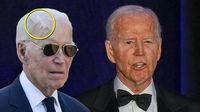Former President Joe Biden’s recent public appearances have set off a flurry of speculation and concern after he was seen with a conspicuous, fresh scar across his forehead during Labor Day weekend in Delaware. The 82-year-old, who served as president from 2021 until January 20, 2025, was recorded greeting supporters outside a church in Rehoboth Beach, a moment that quickly went viral on social media and drew attention from both the press and the public.
Footage first shared by Fred Karger, who filmed Biden leaving the church, showed the former president with a noticeable red wound, partly hidden by his white hair. Karger told Inside Edition, “I was a little surprised cause it’s a noticeable scar.” The video, which spread rapidly online, prompted a cascade of questions about Biden’s health and recent medical history. According to New York Post and Inside Edition, the gash appeared fresh, with some hair combed over the wound, leading to speculation about recent medical procedures.
Adding to the intrigue, Biden was seen the night before at a local ice cream shop, wearing a baseball cap that seemed to cover the injury. Just days earlier, on August 22, 2025, he attended the funeral of former Delaware Governor and Representative Mike Castle at St. Joseph on the Brandywine Church in Greenville, Delaware, sporting a bandage over the same spot on his forehead, as documented by USA TODAY NETWORK and Daily Mail. The mystery was soon clarified by his spokesperson, who confirmed to Daily Mail and other outlets that Biden had recently undergone Mohs surgery, a specialized procedure used to treat skin cancer.
Mohs surgery is a meticulous process, commonly performed in the United States—on approximately 876,000 skin cancers each year, according to Daily Mail. The goal is to remove cancerous tissue layer by layer, examining each sample under a microscope until no cancer cells remain. The procedure is typically performed in an outpatient setting, with patients awake and under local anesthesia. Wounds from Mohs surgery can vary in size; smaller ones may heal on their own within a month, while larger wounds might require sutures and heal in a few weeks.
Biden’s experience with skin cancer isn’t new. In February 2023, he had a cancerous lesion—basal cell carcinoma—removed from his chest, as noted by The Post. His wife, former First Lady Jill Biden, underwent the same Mohs procedure in 2023. The surgery is considered highly effective and aims to spare as much healthy tissue as possible, but the visible aftereffects—like Biden’s recent scar—can be striking, especially in high-profile figures.
The revelation of Biden’s Mohs surgery came amid broader concerns about his overall health. In May 2025, Biden stunned the nation by announcing that he had been diagnosed with an aggressive form of prostate cancer that had already spread to his bones. The diagnosis, made following symptoms related to urinary issues, was particularly dire: doctors assigned it a Gleason score of 9 and a Grade Group of 5, indicating a rapidly spreading and advanced disease. The cancer was found to be hormone-sensitive, a detail that offers some hope for treatment, as reported by New York Post and Daily Mail.
The cancer diagnosis followed the detection of a small nodule on Biden’s prostate, raising questions about how such an advanced case could have gone unnoticed during his four years in the White House. Dr. Howie Forman, a professor at Yale, commented, “It is inconceivable that this was not being followed before he left the Presidency,” noting that a routine prostate-specific antigen test should have revealed the cancer earlier, given its aggressive nature. The situation has fueled allegations, particularly from conservative circles, that the Biden administration and his aides may have concealed the extent of his health decline from the public while he was in office. Reports from the book Original Sin by Jake Tapper and Alex Thompson suggest that some members of Biden’s inner circle actively hid signs of cognitive decline as well.
Despite these revelations, Biden’s longtime physician, Dr. Kevin O’Connor, declared him “fit to serve” in February 2024 after a routine examination at Walter Reed National Military Medical Center. At the time, Biden was the presumptive Democratic nominee for the 2024 presidential election. This official assessment, however, did little to quell suspicions about his physical and cognitive health, particularly after the later disclosure of his advanced cancer diagnosis.
Biden and his family are currently evaluating treatment options for his stage four prostate cancer, consulting with medical professionals to determine the best path forward. The hormone-sensitive nature of the cancer means there are still viable therapies, and the former president’s office has expressed cautious optimism. Still, the diagnosis is serious, and the fact that the cancer had already metastasized to the bone by the time it was discovered underscores the challenges ahead.
The public’s reaction has been a mix of sympathy, concern, and skepticism. On social media, the images of Biden’s head wound fueled widespread discussion about the transparency of presidential health disclosures. Some questioned how such significant medical developments could have been missed or withheld during his presidency, while others expressed empathy for the former president’s ongoing health battles. The episode has reignited broader debates about the age and health of national leaders, a topic that has loomed large in recent American political discourse.
For his part, Biden has remained largely silent about his diagnosis and ongoing treatments, though he has previously stated he believed he could have won the 2024 election had he remained in the race. In the wake of these health revelations, Biden’s public appearances have become less frequent, and his family has taken a more prominent role in managing communications with the media and the public.
The saga of Biden’s health—marked by visible scars, high-stakes surgeries, and a serious cancer diagnosis—has once again brought to the forefront questions about the intersection of personal privacy, public leadership, and the right of citizens to know the state of their leaders’ health. As the former president navigates his medical journey, the nation watches, waiting for updates and hoping for the best in his fight against cancer.
Biden’s story serves as a reminder of the very human vulnerabilities that persist even at the highest levels of power. The coming months will reveal not only the course of his treatment but also the evolving conversation about age, health, and transparency in American public life.


